AIR TRANSPORT Future of civil aviation
Reimagining the future of civil aviation
JIM ANGUS FRAeS, Commercial Director, IVHM Centre, and IAIN GRAY FRAeS, Director of Aerospace, Cranfield, report from the first of a series of virtual summits held by Cranfield University which look at the opportunities for the international aerospace industry in the post-Covid world.
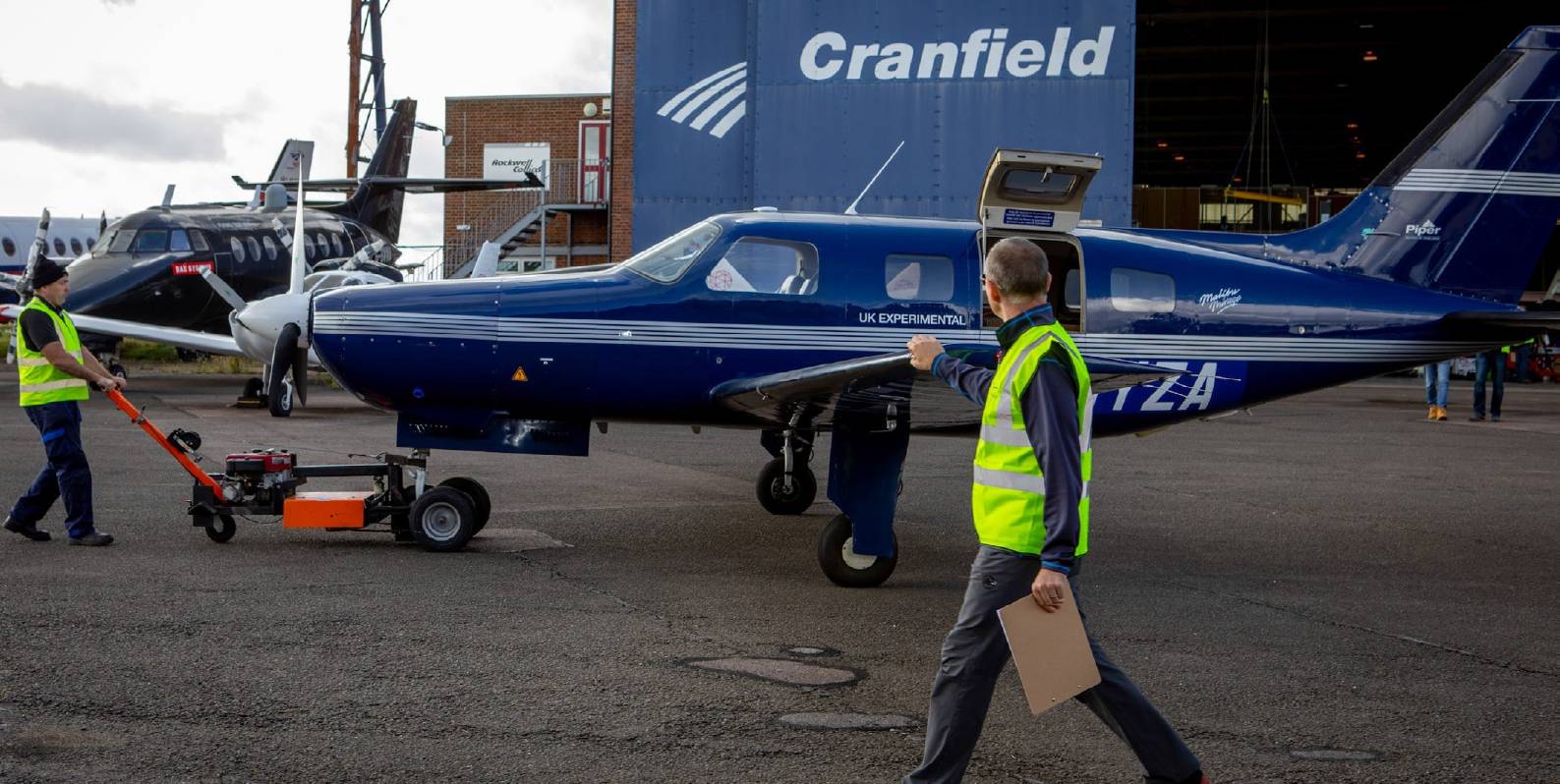 ZeroAvia’s hydrogen fuel cell prototype, in the form of a six-seat Piper M-Class aircraft, at Cranfield. Zeroavia
ZeroAvia’s hydrogen fuel cell prototype, in the form of a six-seat Piper M-Class aircraft, at Cranfield. Zeroavia
For all the financial stresses of the Covid-19 pandemic on civil aviation, the crisis period is also a once-in-a-generation opportunity.
While operations are stalled and broken up there is the space and momentum for fundamental changes in direction. In other words, the chance to introduce changes that were already necessary for sustainability – for meeting the 2050 net zero-carbon emissions targets – and for building a more resilient and profitable sector.
However, for the opportunity not to be lost in disparate or conflicting attitudes, approaches and technologies, there is an urgent need for a shared agenda, a sense of direction and new partnership.
This need was the driving force behind the first of a series of virtual summits led by Cranfield University (16 October 2020) that brought together decision-makers, opinion-influencers and policymakers from global industry, governments and academia.
The event focused on the core issues: what are the short, medium and long-term challenges? Can we still reach the net zero-carbon targets for 2050, despite the effects of the Covid-19 pandemic? Together, how can the future of civil aviation be reimagined?
As part of his contribution to the summit, Grant Shapps, Secretary of State for Transport, emphasised that the civil aviation sector had just 30 years to revolutionise air travel, to reform and modernise the airspace and turn zero-carbon aircraft into a commercial reality.
The minister set out how he wants the UK to become a hotbed for design, manufacture and use of clean aircraft in the 21st Century. The UK must share, he said, in an industry that could be worth £4tn globally by 2050. In 2019 the government announced a £300m joint investment with industry in the Future Flight Challenge to fund electric plane innovation and research into other forms of aviation technology. A further £2bn is being invested in aviation research and technology through the Aerospace Technology Institute programme – part of which involves Cranfield’s work on a groundbreaking project to make electrically-powered commercial flights a reality in the UK within two years. The minister flagged other examples of world-leading UK innovation, such as the world’s first hydrogen fuel cell powered flight of a commercial-grade aircraft by ZeroAvia at Cranfield’s global research airport.
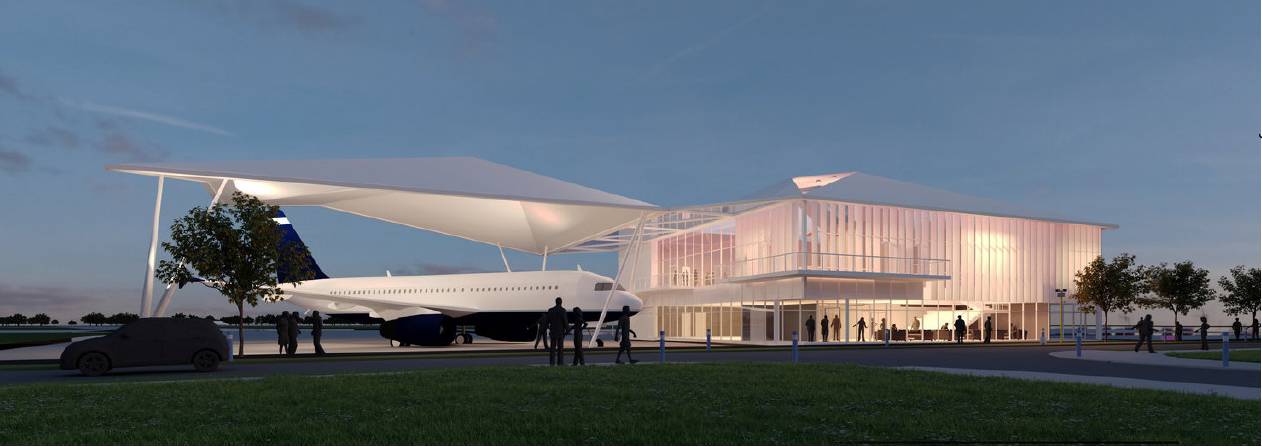 Cranfield’s new DARTeC (Digital Aviation Research and Technology Centre) is set to open later this year. Cranfield University
Cranfield’s new DARTeC (Digital Aviation Research and Technology Centre) is set to open later this year. Cranfield University
Industry resolve
Brian Pearce, Chief Economist at IATA, confirmed the unprecedented level of impact on commercial air travel, the worst since WW2. In April 2020 the number of global passenger kilometres flown was 94% down in comparison to 2019, seeing very little improvement by August 2020. For the air cargo sector the picture was very different, a shortage of capacity rather than a shortage of demand, as nations looked to secure emergency medical supplies and global supply chains.
Pearce predicted that recovery in air travel would be slow even with the mass availability of vaccines. Economic scarring from what will be the biggest recession since the 1930s will mean we cannot expect a recovery of the industry until 2024, he told the summit. There have been few failing businesses so far, mainly due to government cash aid in various forms – but with airlines not expecting to turn cash positive until 2022 and passenger recovery set to be very slow, there remains a high likelihood of business failures. This matters for policymakers, he emphasised, because, air transport is more than just another business: it provides the bridges that rapidly connect cities across the globe, making fundamental pathways for trade, people, investment, competition, knowledge transfer and innovation.
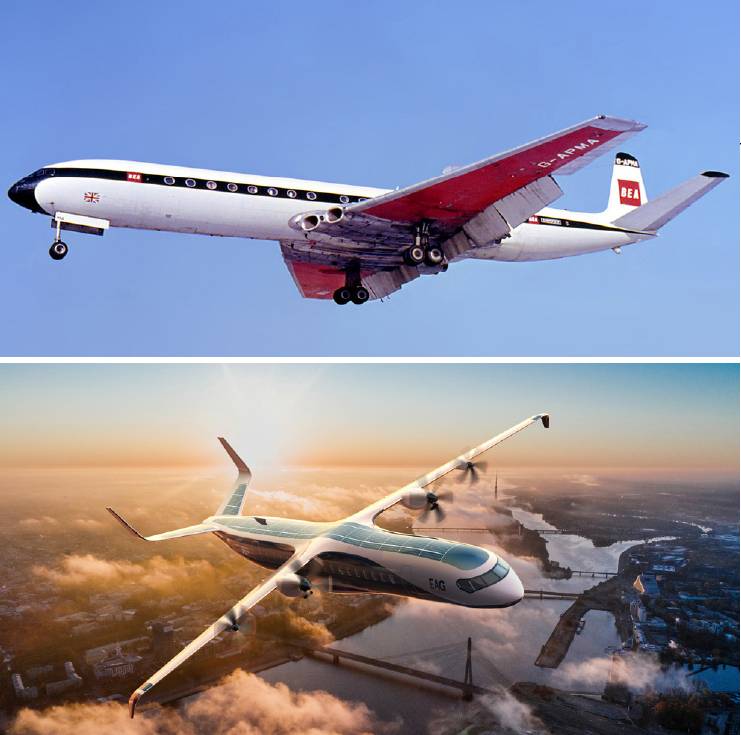 The past and present of UK airliners? Above top: British European Airways (BEA) Comet 4B arriving at Berlin Tempelhof Airport in 1969. Above lower: HERA is a 70-seat hybrid-electric airliner concept from Electric Aviation Group. Ralf Manteufel/Wikipedia and EAG
The past and present of UK airliners? Above top: British European Airways (BEA) Comet 4B arriving at Berlin Tempelhof Airport in 1969. Above lower: HERA is a 70-seat hybrid-electric airliner concept from Electric Aviation Group. Ralf Manteufel/Wikipedia and EAG
Low-cost carrier perspective
An industry perspective came from Jane Ashton, who joined easyJet as Head of Sustainability just weeks before the first UK lockdown. The whole easyJet fleet was grounded for 11 weeks during European lockdown, returning to around 40% capacity in the summer due to the opening of some travel corridors. The airline is not expecting to return to 2019 levels of service until at least 2023.
Despite the crisis, she explained how easyJet had continued with its commitment to sustainability, reducing carbon emissions and stimulating carbon innovation. Given its low-cost carrier business model, there has always been a concerted focus on forensically tracking and improving fuel efficiency. With fuel efficiency improving by more than one-third between 2000 and 2019, the introduction of A320neo aircraft into the fleet since 2017 has created a 15% fuel efficiency increase, as well as being 50% quieter than the previous generation aircraft they replaced. More neo aircraft are due to enter the fleet over the next few years, albeit with a deferral of a number of new aircraft due to the impact of Covid-19. EasyJet’s board decided in 2019 to invest in immediate measures to mitigate the airline’s carbon footprint via offsetting – 20% in renewables, and the majority in nature-based carbon credits in the form of reforestation, afforestation and avoided deforestation. However, Jane Ashton acknowledges that offsetting could only be an interim measure; the primary focus needed to be on new technology adoption. The concern, in the short to medium term, was that airlines and manufacturers would struggle financially to invest in cleaner technology.
The canary in a coal mine
Covid-19 is like a canary in a coal mine, said Jonathan Counsell, Group Head of Sustainability for IAG and Chair of IATA Sustainability & Environment Advisory Council. It is a demonstration of the scale of disruption that can be caused by naturally-occurring events – and a warning about the even bigger threat posed by climate change. He set out the impact on IAG and the particular damage from depreciation costs of aircraft. In a single quarter, IAG had seen a £2.4bn fall in profits. The group had planned for delivery of 143 new aircraft by 2022, now reduced to 75, with the group also looking at early retirement of 53 long-haul aircraft. At the same time, climate change commitments were still high on the group’s agenda, with three targets: a carbon efficiency target by 2025, reduction in net emissions by 2030 and net zero emissions by 2050.
Owain Jones, Managing Director of Wizz Air UK, described how the business was diversifying to deal with cost pressures: reviewing its network and schedule and identifying and opening up 12 new bases across Europe and 200 new routes. There is the need for slot reform, he argued, with Europe making up half of the world’s most congested airports – a crunch that is hampering competition, limiting air connectivity and passenger choice. There was a case, in this context, for incentivising green operations and those airlines which were most efficient.
Digital cargo
The need for digitalisation of cargo journeys has been amplified by the pandemic, said Vladimir Zubkov, advisor to The International Air Cargo Association (TIACA). Documentation handover can contribute to the spread of the virus, so digital transfer and contactless movement is important, just as much as it is on the passenger side. Zubkov explained how cloud-based applications for airport communities are helping formerly fragmented air cargo communities (including shippers, carriers and customs) to work together using consistent data. There is a need for innovation, he said, particularly digitalisation and training of people, in order to respond to the current challenge and prepare for the future.
2050 vision
A vision for 2050 of seamless, safe and sustainable air travel was set out by Professor Graham Braithwaite, Director of Transport Systems at Cranfield. Realising this vision, he said, meant looking at all the components of the industry and how they interact, what Cranfield terms as the four As: Airspace, Aircraft, Airports and Airlines. A holistic view is needed that also takes into account the whole air travel experience, including how people travel to and from airports: how to make it enjoyable, safe and sustainable.
 The UK Secretary of State for Transport, Grant Shapps. UK Gov/Crown copyright
The UK Secretary of State for Transport, Grant Shapps. UK Gov/Crown copyright
Cranfield’s Digital Aviation Research and Technology Centre (DARTeC) is being used to test technologies for touchless passenger transfer, as well as, for example, simulating experiences for those who find travel challenging, for example disabled passengers or the elderly. The centre’s rapid testing and simulation capabilities are being used to model digital twins and test the interconnected air transport management system. Our airspace needs a fundamental redesign, he said, to cope with growth but also to cope with other users in the same airspace. We need to adapt air traffic management systems to allow for point-to-point flying.
Professor Braithwaite emphasised the importance of business transformation and managing innovation – the challenges would not be solved just through engineering and science. One airline, for example, has ambitiously stated its dream is for passengers to spend just three to four minutes in terminals of the future but the question is how do we pay for this and make it sustainable?
Reimagining the future
The second half of the summit was an interactive forum where a range of contributors from industry, government and academia shared their views on aviation for 2050. The main threads were:
- How disruptive technologies must be used, particularly for short-haul flights; electric for shorter-range journeys, providing a huge benefit in terms of noise pollution, and hybrid electric increasing the range length further.
- How sustainable aviation fuels will be the primary decarbonisation route for long haul, with nuclear being a potential source of e-fuels. Small nuclear reactors can drive the price of electricity down, creating an economic pathway to produce sustainable aviation fuels from low-cost nuclear to hit 2050 targets.
- One of the main outcomes from the pandemic will be a global agreement and approach to sanitisation and security before getting on an aircraft. There will also be an impact on business travel, with virtual conferencing used to a greater degree.
- How we need to employ innovative solutions across the product cycle to increase efficiency.
- That, ultimately, there are enormous technological challenges ahead that we must overcome. The right thing for the industry and academia to do is to keep pushing technology, to take risks and strive for zero emissions.
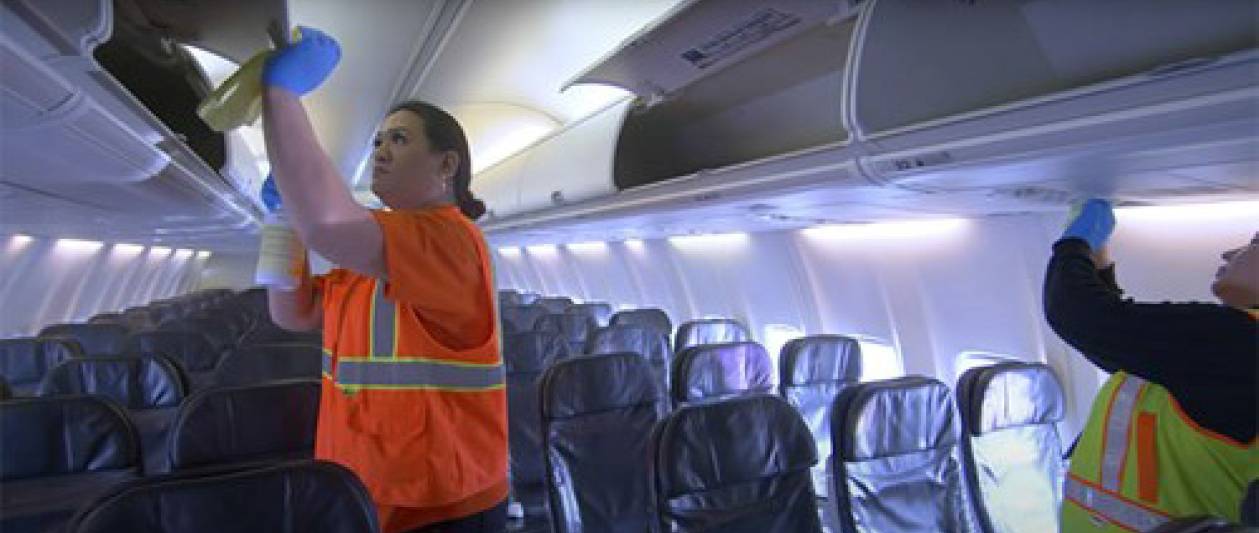 Alaska Airlines’ aircraft cleaning. easyJet
Alaska Airlines’ aircraft cleaning. easyJet
In his keynote, Sir Martin Donnelly, President of Boeing Europe and Managing Director UK, said that the industry had to accept its lack of control over some of the short and long-term influences that determine the outcomes for our industry but, at the same time, recognise aviation’s place among societal priorities. Aviation represents far more than going from point to point. It remains a huge driver of the global service economy and has long been a reliable source of technological advancement, particularly in terms of digital, and our unique value in the advanced manufacturing and service economy. Sir Martin concluded with three points he believes the industry should be focusing on immediately:
1. Being active and engaged in societal dialogues around what we do and how we do it.
That means accepting different perspectives of aviation and engaging in the debates on vaccines and quarantine; talking about aviation’s role in the climate emergency; and including opening up dialogue around why we are not managing airspace better and not moving aircraft around on the ground more efficiently. Also, working with national authorities to ensure the industry can maximise the efficiency of production of sustainable fuels – as there will be key governmental decisions to come on the rate of relative support for sustainable aviation fuels compared with kerosene.
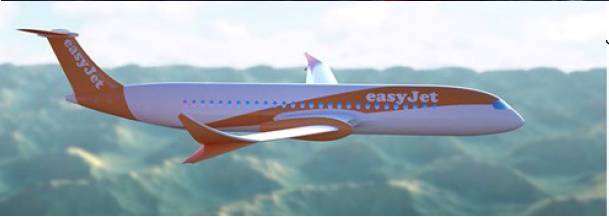 EasyJet future electric passenger aircraft concept. easyJet
EasyJet future electric passenger aircraft concept. easyJet
2. Remaining competitive and solvent.
How the sector must find ways to maintain its research base, innovation, disruptive technologies and supply chains in the face of the pandemic. Losing these will be a huge benefit to Asian providers. The Asian aviation market has responded differently to the pandemic and has now almost recovered to pre Covid-19 levels. The right decisions need to be made quickly, he said.
3. Considering how we work together more effectively in the wider environment.
The industry needs to get through this short-term cash squeeze, but in the medium-term needs to support the globalisation of economic activity through open research and the movement of people and data, as a means of protecting trade relations. More active dialogue will be needed across the globe, particularly with China, and with all forms of regulators, not just in aviation. For example, can we create a shared virus management system to create a greater degree of transparency on what happens with an upsurge of cases?
In order to keep the future of aviation debate alive among stakeholders in the UK and internationally, a follow-up event is planned for 2021, focusing on developments in the Asia Pacific market.
 ZeroAvia’s hydrogen fuel cell prototype, in the form of a six-seat Piper M-Class aircraft, at Cranfield. Zeroavia
ZeroAvia’s hydrogen fuel cell prototype, in the form of a six-seat Piper M-Class aircraft, at Cranfield. Zeroavia Cranfield’s new DARTeC (Digital Aviation Research and Technology Centre) is set to open later this year. Cranfield University
Cranfield’s new DARTeC (Digital Aviation Research and Technology Centre) is set to open later this year. Cranfield University


